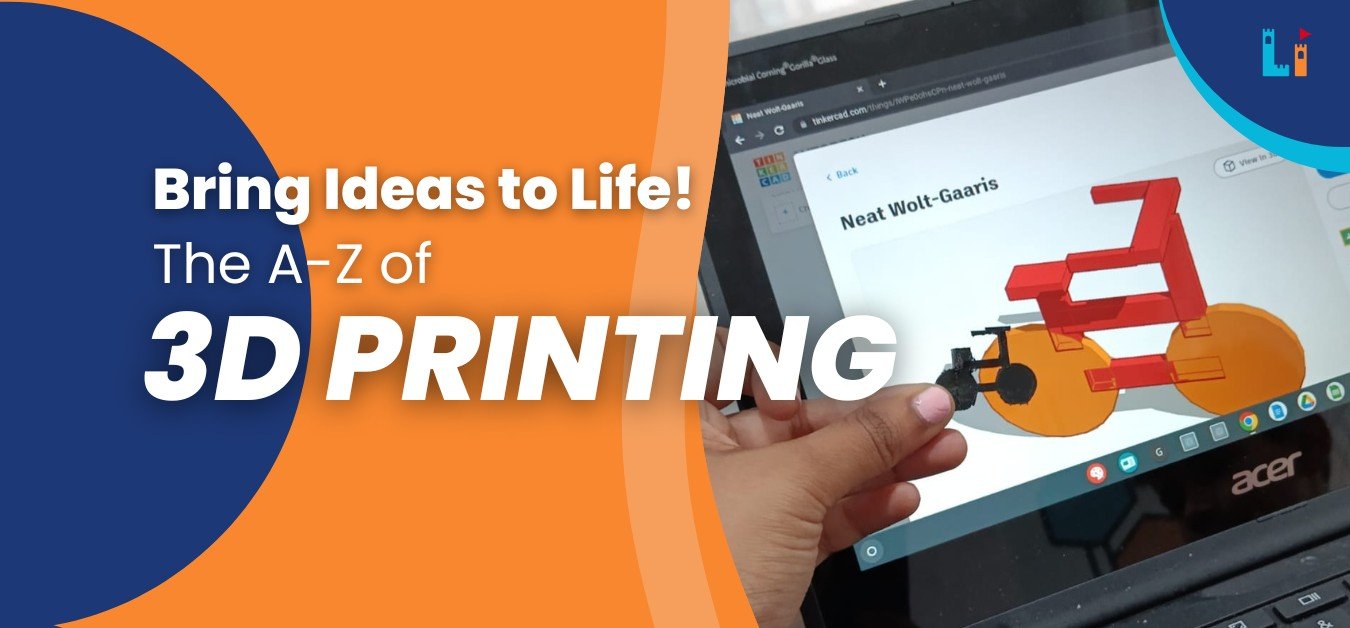Introduction
3D printing is a groundbreaking technology that is transforming education by providing hands-on learning experiences that enhance creativity, problem-solving abilities, and technical skills. As its relevance continues to grow, it offers children an exciting way to bring their ideas to life. This guide helps parents understand the benefits of 3D printing for kids and provides essential insights on how to get them started with this innovative technology. Explore our 3D Designing and Printing Course for Kids to give your child a head start in this dynamic field!
What is 3D Printing?
Definition and Basic Principles:
3D printing, also known as additive manufacturing, involves creating three-dimensional objects from a digital file by layering material. It is a process where objects are built up layer by layer, which contrasts with traditional subtractive manufacturing methods.
How 3D Printing Works: An Easy-to-Understand Explanation:
1. Design Creation: First, a digital 3D model is designed using computer-aided design (CAD) software.
2. File Conversion: The digital model is converted into a format that the 3D printer can read, typically a .STL file.
3. Printing Process: The 3D printer reads the file and starts layering the material, following the design specifications, until the object is complete.
Common Materials and Tools Used in 3D Printing:
– Materials: Plastics (PLA, ABS), resins, and metals.
– Tools: 3D printers, Tinkercad, UltiMaker Cura (for converting files), and post-processing tools (for finishing touches).
Benefits of 3D Printing for Kids
1. Enhances Creativity and Imagination
3D printing allows children to bring their ideas to life, fostering creativity. They can design and print custom toys, art pieces, and tools, encouraging imaginative thinking and design skills.
2.Develops Problem-Solving Skills
Designing and printing 3D objects involves overcoming challenges like optimising designs and troubleshooting. This iterative process teaches kids resilience, critical thinking, and persistence.

3.Teaches Design and Engineering Principles
Kids learn about dimensions, scaling, geometry, and structural integrity through 3D printing. These foundational engineering concepts are valuable for advanced studies and practical applications.
4.Encourages Teamwork and Collaboration
3D printing projects often involve teamwork, requiring children to communicate, share ideas, and divide tasks. This collaborative environment builds social skills and the ability to work towards common goals.
5.Prepares Kids for Future Technological Advancements
Early exposure to 3D printing equips children with skills for a tech-driven future, opening doors to careers in engineering, architecture, manufacturing, and design.
Getting Started with 3D Printing
Children can start learning about 3D printing as early as 8 years old. At this age, they can grasp fundamental concepts and begin exploring the basics of design with proper guidance. It’s important for them to be supervised to ensure safety and to provide assistance as they explore this new technology. Early exposure helps build a solid foundation, allowing them to tackle more advanced projects as they grow.
For a more structured approach, you can check out this 3D Animation using Blender course for kids offered by Little Inventors, designed to teach them the basics in a fun and engaging way.
Projects and Ideas for Kids
Fun and Educational Project Ideas: Engaging children with fun and educational 3D printing projects can spark their interest and enhance their learning experience. Some project ideas include:
- Customised keychains with their names or favourite shapes
- Simple geometric shapes to understand basic design principles
- Miniature models of buildings, vehicles, or animals
- Functional items like bookmarks, pencil holders, or small toys
Step-by-Step Guides for Beginner Projects: To ensure success and build confidence, start with beginner-friendly projects. Here’s a simple guide for creating a personalised keychain:
- Design: Use a kid-friendly CAD software to draw the shape of the keychain.
- Add Text: Insert the child’s name or initials onto the design.
- Prepare for Printing: Convert the design into a .STL file using slicer software.
- Print: Load the file into the 3D printer and start the printing process.
- Finishing Touches: Once printed, remove the keychain and smooth any rough edges.
How to Encourage Your Child to Come Up with Their Own Projects: Inspire creativity by encouraging your child to think about their interests and how they can create related objects. Here are a few tips:
- Brainstorming Sessions: Hold regular brainstorming sessions where your child can sketch ideas.
- Exploration: Encourage them to explore different CAD software and 3D printing resources online.
- Problem-Solving: Ask them to identify problems they can solve with a 3D-printed solution, fostering a mindset of innovation and practicality.
Conclusion:
Little Inventors offers comprehensive 3D printing classes designed to guide children through the learning process in a structured and fun way. Our courses are tailored to different age groups and skill levels, ensuring each child receives the appropriate level of challenge and support.
Enrol your child in Little Inventors’ 3D printing courses to give them a head start in this exciting field. Our expert instructors and hands-on approach ensure an enriching educational experience.
For more information, visit Little Inventors or contact us at contact@littleinventors.in. We’re here to answer any questions and help you get started.

